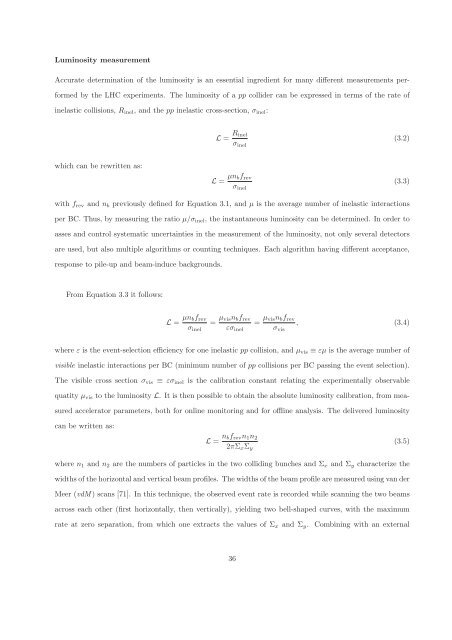CERN-THESIS-2012-153 26/07/2012 - CERN Document Server
CERN-THESIS-2012-153 26/07/2012 - CERN Document Server
CERN-THESIS-2012-153 26/07/2012 - CERN Document Server
You also want an ePaper? Increase the reach of your titles
YUMPU automatically turns print PDFs into web optimized ePapers that Google loves.
Luminosity measurement<br />
Accurate determination of the luminosity is an essential ingredient for many different measurements per-<br />
formed by the LHC experiments. The luminosity of a pp collider can be expressed in terms of the rate of<br />
inelastic collisions, Rinel, and the pp inelastic cross-section, σinel:<br />
which can be rewritten as:<br />
L = Rinel<br />
σinel<br />
L = µnbfrev<br />
σinel<br />
with frev and nb previously defined for Equation 3.1, and µ is the average number of inelastic interactions<br />
per BC. Thus, by measuring the ratio µ/σinel, the instantaneous luminosity can be determined. In order to<br />
asses and control systematic uncertainties in the measurement of the luminosity, not only several detectors<br />
are used, but also multiple algorithms or counting techniques. Each algorithm having different acceptance,<br />
response to pile-up and beam-induce backgrounds.<br />
From Equation 3.3 it follows:<br />
L = µnbfrev<br />
σinel<br />
= µvisnbfrev<br />
εσinel<br />
(3.2)<br />
(3.3)<br />
= µvisnbfrev<br />
, (3.4)<br />
σvis<br />
where ε is the event-selection efficiency for one inelastic pp collision, and µvis ≡ εµ is the average number of<br />
visible inelastic interactions per BC (minimum number of pp collisions per BC passing the event selection).<br />
The visible cross section σvis ≡ εσinel is the calibration constant relating the experimentally observable<br />
quatity µvis to the luminosity L. It is then possible to obtain the absolute luminosity calibration, from mea-<br />
sured accelerator parameters, both for online monitoring and for offline analysis. The delivered luminosity<br />
can be written as:<br />
L = nbfrevn1n2<br />
2πΣxΣy<br />
where n1 and n2 are the numbers of particles in the two colliding bunches and Σx and Σy characterize the<br />
widths of the horizontal and vertical beam profiles. The widths of the beam profile are measured using van der<br />
Meer (vdM) scans [71]. In this technique, the observed event rate is recorded while scanning the two beams<br />
across each other (first horizontally, then vertically), yielding two bell-shaped curves, with the maximum<br />
rate at zero separation, from which one extracts the values of Σx and Σy. Combining with an external<br />
36<br />
(3.5)















